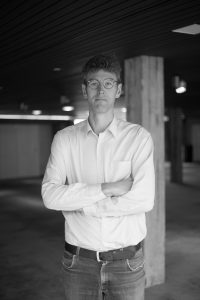Wolfram Höhne

CV
since 2021 Scientific Coordinator of the DFG Research Training Group 2227 “Identity and Heritage”
2016-2020 PhD in History and Sociology of Architecture in the Research Training Group “Identity and Heritage”
2012-2016 Development of the study programme “Knowledge Mediation through Film” at the Centre for University Development at the Bauhaus-Universität Weimar
2005-2016 Artistic staff member at the Chair of Media Events at the Bauhaus-Universität Weimar
2001-2005 Research assistant at the Chair of Comparative Literature and Media at the University of Erfurt
Since 2001 freelance work on films and art projects
1995-2000 Study of Fine Arts at the Bauhaus University Weimar (Diploma)
1993-1995 Internship in metal conservation, Bau- und Denkmalpflege Dresden
Contact
Bauhaus-University Weimar
Faculty of Architecture and Urbanism
DFG Research Training Group 2227 “Identity and Heritage”
D-99421 Weimar
Office: Marienstraße 9 (Room 105)
D-99421 Weimar
wolfram.hoehne[at]uni-weimar.de
A narrative as a monument. The method of narrative reconstruction using the example of the space flight planetarium “Sigmund Jähn” in Halle an der Saale.
In 1978, the city of Halle opened its space flight planetarium. At the time, the structure was a technical innovation in two respects. Zeiss Jena uses the planetarium to present a new generation of star projectors. And it surprises with its unusual architecture. The building owes its unusual design to a system construction method in which thin-walled reinforced concrete shells are produced as prefabricated parts and assembled to form facades and roofs. Over the years, the planetarium became an important part of the educational biography of many people in Halle. When a flood severely damaged the building in 2013, the city administration decided to demolish the building, which is now a listed monument. To this day, this decision remains controversial. Because the loss of the architectural monument is planned, the material and spatial condition of the structure is recorded according to the requirements of monument law. Undocumented, on the other hand, is the past that makes the house a controversial heritage. A controversial legacy.
Based on institutionalized monument preservation procedures, Wolfram Höhne develops an alternative method for documenting endangered architectural monuments. Methodological criteria for the selection of testimonies, their arrangement into narrative structures, and the use of narrative text forms in historiographical texts are developed and tested using the object biography of the Space Flight Planetarium. As the structural shell is demolished in winter 2018, the author assembles the fragments of what has survived into a historiographic text. Telling the story backwards, the building biography uncovers different layers of time. Beginning with the afterlife of the building at its former location, the author describes how the GDR’s architectural legacy was dealt with in the post-reunification period and ultimately takes the reader back to the origins of modern and socialist utopias of progress. Contradictory narratives are presented. The scientific-technical fascinations of state socialism are juxtaposed with the individual life plans of individual biographies, but also with the idea of disposing of old burdens, which dominated after the fall of the Wall.
Publications
Foerster, L./ Höhne, W./ Markert, M.: Menschen, Tiere, Irritationen. Erkundungen mit der Filmkamera im Phyletischen Museum, in: Dinccag Kahveci, A./Gegidze, M/ Lopez, P. S./ Vogl, J. (Ed.): Dinge, die verbinden, Weimar 2024.
Höhne, W.: Eine Erzählung als Denkmal. Die Methode der narrativen Rekonstruktion am Beispiel des Raumflug-Planetariums „Sigmund Jähn“ in Halle an der Saale, Weimar 2024.
Hajdu, M./ Höhne, W./ Jesse, D./ Dinccag Kahveci, A./ Karpf, M./ Torres Ruiz, M. (Ed.): Censored? Conflicted Concepts of Cultural Heritage, Weimar 2023.
Höhne, W.: Narrative Rekonstruktionen. Zur Historiografie eines abgebrochenen Bauwerks, in: Bogner, S./ Dolff-Bonekämper, G./ Meier, H. R. (Ed.): Instabile Konstruktionen, Weimar 2022.
Höhne, W./ Stemmler, A.: Durchleuchten: Spurensuche in Unterrichtsfilmen der DDR, in: Forster, B./ Klinger, K./ Markert, M. (Ed.): Sammlungsdidaktik. Die ‚nicht mehr neuen‘ Medien in den Universitätssammlungen, Weimar 2016.
Höhne, W.: Kunstpraxis als Projekt und Projektstudium, in: Taschitzky, T. (Ed.): Vom Labor zum Projekt, Weimar 2011.
Katz Ben Shalom, Y./ Herrmann, J./ Höhne, W./ Paeslack, A. (Ed.): Das Vermögen der Kunst, Köln 2008.
Bußejahn, F./ Herrmann, J./ Höhne, W./ Paeslack, A./ Suchy, S. (Ed.): ÄsthEthik. Was hat Kunst mit Armut zu tun?, Erfurt 2007.
Herrmann, J./ Höhne, W./ Paeslack, A.: Thesen zu Kunst und Öffentlichkeit, in: Schweppenhäuser, G. (Ed.): Philosophische Diskurse, Weimar 2005.
Höhne, W. et al. (Ed.): Katzengold. Ausstellungskatalog in der Reihe „Wie konnte das Einhorn die Sintflut überstehen?” (Teil 5), Weimar 2003.
Herrmann, J./ Höhne, W./ Paeslack, A.: Die blaue Bank, in: Kretschmann, I.: Inspiration Moritzburg: Kunst im 20. Jahrhundert, Moritzburg 2001.
Films
Human Beings in the Museum, Documentary, 33 min, 2023
Songs Without a Place, Documentary, 55 min, 2021
Elham – meine Musik für Afghanistan, Children’s Film (ZDF-Redaktion: stark!), 15 min, 2014
From the Second Life, Film series on exile biographies of Jewish architects (collaboration with the Centre for Documentary Architecture), 2013-2017
Das Kämpfer-Gen, Documentary, 55 min, 2011
Die ganze Natur, Harald Lesch explores Goethe’s scientific work, DVD (Komplett Media), 2010
Studio Bauhaus, Platform for academic films at the Bauhaus-Universität Weimar, 2008-2012
Artworks
Das Schweigen des Sichtbaren (film based research on the heritage of Wismut AG at the Federal Horticultural Show), Gera, 2007
Das Vermögen der Kunst (Tour through Germany with Israeli, Arab and German artists), Exhibition at Kunsthaus Dresden, 2005
Was in den Sternen steht (Art in architecture project), Fachhochschule der Polizei Rothenburg, 2004
Show Your Wound (exhibition), Goethe Institut Tel Aviv, 2003
Simultane Perspektiven (bronze casting), Tower of the Dresden Technical Museum, 2003
Platz der Zukunft (Billboard advertising of urban development visions), Theaterhaus Jena, 2002
Katzengold (Exhibition of corresponding objects from the Maenz Collection), Neues Museum Weimar, 2002
Die blaue Bank (Theatre play on the history of art in the 20th century), Kollwitz-Gedenkstätte Moritzburg, 2000
Barockhaus (Participatory projects with local villagers), Moritzburg, 2000